
Emergency medical services (EMS), also known as ambulance services or paramedic services, are emergency services that provide urgent pre-hospital treatment and stabilisation for serious illness and injuries and transport to definitive care. They may also be known as a first aid squad, FAST squad, emergency squad, ambulance squad, ambulance corps, life squad or by other initialisms such as EMAS or EMARS.

An emergency medical technician is a medical professional that provides emergency medical services. EMTs are most commonly found serving on ambulances and in fire departments in the US and Canada, as full-time and some part-time departments require their firefighters to at least be EMT certified.
The Seattle & King County Emergency Medical Services System is a fire-based two-tier response system providing prehospital basic and advanced life support services.
A medical director is a physician who provides guidance and leadership on the use of medicine in a healthcare organization. These include the emergency medical services, hospital departments, blood banks, clinical teaching services, and others. A medical director devises the protocols and guidelines for the clinical staff and evaluates them while they are in use.
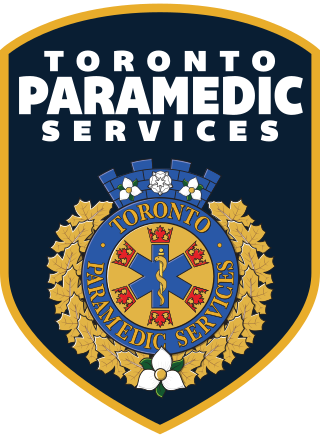
The City of Toronto Paramedic Services is the statutory emergency medical services provider in Toronto, Ontario, Canada. The service is operated as a division of the City of Toronto, under the Community & Social Services cluster. The service is funded by the municipal tax base, and operates similarly to other municipal divisions, such as the Toronto Parks, Forestry & Recreation division, or the Toronto Water division, but retains operational independence from other divisions. While under municipal government control, it is subject to provincial legislation and licensing. It is not the only service provider in its area; private-for-profit medical transport services also provide routine, non-emergency transports and coverage for special events, but the statutory emergency medical system is the only provider permitted to service emergency calls.

A nontransporting EMS vehicle is a vehicle that responds to and provides emergency medical services (EMS) without the ability to transport patients. For patients whose condition requires transport, an ambulance is necessary. In some cases they may fulfill other duties when not participating in EMS operations, such as policing or fire suppression.

The California Emergency Medical Services Authority is an agency of California State government. The California EMS Authority is one of the thirteen departments within the California Health and Human Services Agency. The director is required to be a physician with substantial experience in emergency medicine. Elizabeth Basnett is the current Acting Director.

In the United States, the paramedic is an allied health professional whose primary focus is to provide advanced emergency medical care for patients who access Emergency Medical Services (EMS). This individual possesses the complex knowledge and skills necessary to provide patient care and transportation. Paramedics function as part of a comprehensive EMS response under physician medical direction. Paramedics often serve in a prehospital role, responding to Public safety answering point (9-1-1) calls in an ambulance. The paramedic serves as the initial entry point into the health care system. A standard requirement for state licensure involves successful completion of a nationally accredited Paramedic program at the certificate or associate degree level.

Metropolitan Ambulance Services Trust ("MAST") is a former non-profit EMS agency that was the sole ambulance provider for Kansas City, Missouri. On April 25, 2010, MAST was merged into the Kansas City Fire Department to operate as one municipal services department. There are now 21 Statically Deployed ALS transport ambulances deployed from 19 different Fire Stations, with additional Dynamically deployed ALS transport ambulances scheduled throughout each day, totalling 33 dynamic shifts.
Public Utility Model (PUM), is an emergency medical service (EMS) system. In a Public Utility Model system, the government is a "purchaser" of dispatchers, emergency medical technicians (EMTs) and paramedic providers from an EMS provider (contractor). In most cases, this is a private (for-profit) ambulance company. In the ownership of a Public Utility Model, the community retains control of EMS system capital assets and accounts receivable through daily oversight. The EMS provider (contractor) manages the day-to-day operations of the service and provides the system with properly trained providers.

Louisville Metro Emergency Medical Services is the primary provider of pre-hospital life support and emergency care within Louisville-Jefferson County, Kentucky. LMEMS is a governmental department that averages 90,000 calls for service, both emergency and non-emergency, each year.
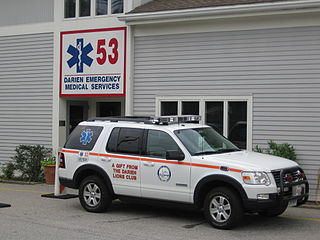
In the United States, emergency medical services (EMS) provide out-of-hospital acute medical care and/or transport to definitive care for those in need. They are regulated at the most basic level by the National Highway Traffic Safety Administration, which sets the minimum standards that all states' EMS providers must meet, and regulated more strictly by individual state governments, which often require higher standards from the services they oversee.
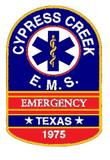
Cypress Creek Emergency Medical ServicesAssociation, also known as Cypress Creek EMS (CCEMS) was a private, non-profit emergency medical service provider for Harris County ESD 11 in North Harris County, within greater Houston, Texas. In 2021, CCEMS declared bankruptcy and operations ceased in mid 2022. In late 2022, the remaining assets, branding, and trademarks were bought by Viking Enterprises, DBA City Ambulance Service. All ambulances in use by CCEMS are Mobile Intensive Care Units (MICU), with at least one Paramedic, making all ambulances ALS units. Cypress Creek EMS provided 911 service in North Harris County, provided bicycle medic teams for special events, provided tactical EMS support for federal, state, and local law enforcement, and operated an accredited educational institution.
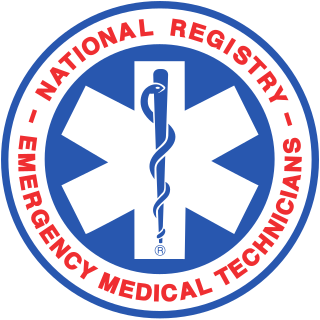
The National Registry of Emergency Medical Technicians (NREMT) is a US based, non-profit certification organization for pre-hospital emergency medical providers that exists to ensure that every Emergency Medical Technician has the knowledge and skills required for competent practice.
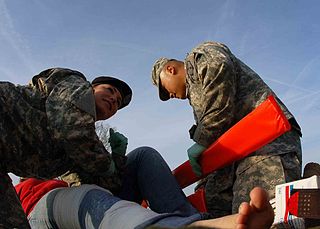
Emergency Medical Responders (EMRs) are people who are specially trained to provide out-of-hospital care in medical emergencies, typically before the arrival of an ambulance. Specifically used, an emergency medical responder is an EMS certification level used to describe a level of EMS provider below that of an emergency medical technician and paramedic. However, the EMR is not intended to replace the roles of such providers and their wide range of specialties.
Emergency medical services in Israel are provided by the Magen David Adom (MDA) organization, and in some places by the Palestinian Red Crescent Society. The phone number to call for an ambulance is 101

The New York City Fire Department Bureau of Emergency Medical Services is a division of the New York City Fire Department (FDNY) in charge of emergency medical services for New York City. It was established on March 17, 1996, following the merger of the FDNY and New York City Health and Hospitals Corporation's emergency medical services division. FDNY EMS provides coverage of all five boroughs of New York City with ambulances and a variety of specialized response vehicles.
The Virginia Beach Department of Emergency Medical Services is the 911 EMS provider for Virginia Beach, Virginia. Virginia Beach is the largest city in the United States with a volunteer based EMS system. Since the 1940s Virginia Beach has offered free pre-hospital emergency services through 10 volunteer rescue squads supported by 1,100+ volunteers throughout the city. Virginia beach EMS has also been a leader in a variety of pre-hospital technologies including 12-lead transmission,EZ-IO technology and therapeutic hypothermia,rapid sequence induction and intubation (RSII),video laryngoscope,end tidal CO2 monitoring,S T Elevation Myocardial Infarction (STEMI) and Stroke programs and community CardioPulmonary Resuscitation (CPR),among others. These programs and more have contributed to the 36% cardiac arrest survival rate (2012).
Middlesex-London Paramedic Service is the statutory Emergency medical services provider for Middlesex County, and London, Ontario. The service provides Paramedic Services to the City of London, and the Townships of Adelaide Metcalfe, Lucan Biddulph, Middlesex Centre, North Middlesex, Southwest Middlesex, Strathroy-Caradoc, Thames Centre, Newbury. Middlesex London Paramedic Service delivers ambulance service to Middlesex and London in accordance with service and patient care standards set by the County of Middlesex, City of London, and Ministry of Health and Long Term Care. Medical oversight for controlled medical acts is provided under the direction of the Southwestern Ontario Regional Base Hospital Program.

The Pittsburgh Bureau of Emergency Medical Services (PEMS) provides emergency medical services and medically directed rescue services for the City of Pittsburgh, Pennsylvania. It is a bureau of the Department of Public Safety (DPS), along with the Bureaus of Police, Administration, Fire, and Animal Care and Control. The department is responsible for 55.5 square miles (144 km2) with a population of 305,841 as of the 2013 Census estimation. The Bureau was founded in 1975 by the then current city administration, absorbing Freedom House Ambulance. In addition, the Bureau of EMS was one of the first EMS agencies in the world.












